OXNARD, Calif. — On a Wednesday morning in December 2023, Dale Perizzolo’s math class at Adolfo Camarillo High School is anything but quiet. Students chat about the data analysis they’ve performed on their cellphone usage over a week, while Perizzolo walks around the room fielding their questions.
The students came up with the project themselves and designed a Google form to track their phone time, including which apps they used most. They also determined the research questions they’d ask of the data — such as whether social media use during class reduces comprehension and retention.
“It’s more real-world math,” said Nicolas Garcia, a senior in Perizzolo’s class. “We have the chance and freedom to choose what we’re doing our datasets on, and he teaches us how we’re going to work and complement it [in] our daily lives.”
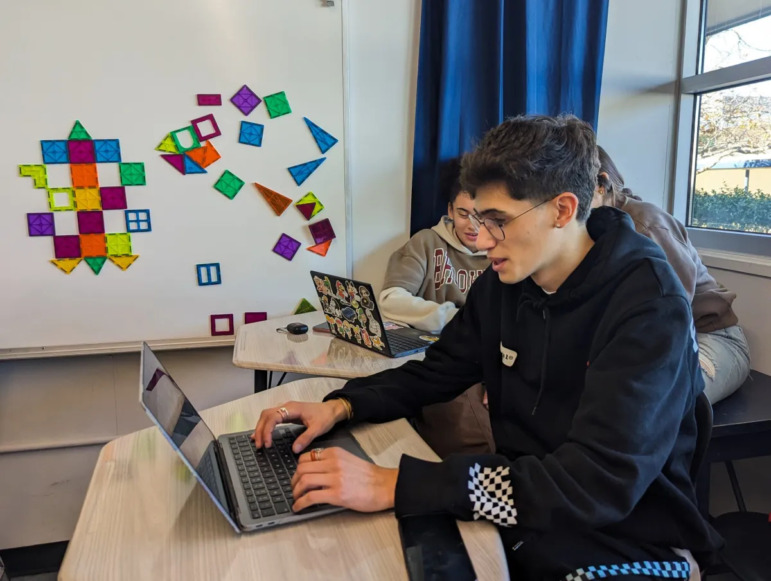
Javeria Salman/The Hechinger Report
Nicolas Garcia, a senior at Adolfo Camarillo High School, analyzes data that he gathered on his cellphone use during the school day. He said he plans to use the skills he learned in the class when in college.
Across town, students in Ruben Jacquez’s class at Rio Mesa High School use coding software to compile and clean data they’ve collected on student stress levels. A few miles away at Channel Islands High School, Miguel Hernandez’s students use pie and bar charts to analyze a dataset about how social media influences people’s shopping habits.
Perizzolo, Jacquez and Hernandez are among the eight math teachers of an increasingly popular data science course offered at most schools in the Oxnard Union High School district, an economically diverse school system northwest of Los Angeles, where 80 percent of students identify as Hispanic. The district rolled out the class in fall 2020, in an attempt to offer an alternative math course to students who might struggle in traditional junior and senior math courses such as Algebra II, Pre-Calculus and Calculus.
Defying criticism, one district says substituting data science for Algebra II has reaped rewards
California has been at the center of a heated debate over what math knowledge students really need to succeed in college and careers. With math scores falling nationwide, some educators have argued that the standard algebra-intensive math pathway is outdated and needs a revamp, both to engage more students and to help them develop relevant skills in a world increasingly reliant on data. At least 17 states now offer data science (an interdisciplinary field that combines computer programming, math and statistics) as a high school math option, according to the group Data Science for Everyone. Two states — Oregon and Ohio — offer it as an alternative to Algebra II.
But other math educators have decried a move away from Algebra II, which they argue remains core to math instruction and necessary for students to succeed in STEM careers and beyond. In California, that disagreement erupted in October 2020, after the group that sets admission requirements for the state’s public university system (known as A-G) announced it would allow students to substitute data science for Algebra II to help more students qualify for college. Math professors, advocates and even some high school educators argued that the state was watering down standards and setting students up for failure in college.
Then, in July last year, the group reversed its earlier decision, and in February released new recommendations reiterating that data science courses (and, to the surprise of some experts, even long-approved statistics classes) cannot be used as an alternative to Algebra II. It remains unclear how the decision will reshape college admissions; additional guidance is expected in May.
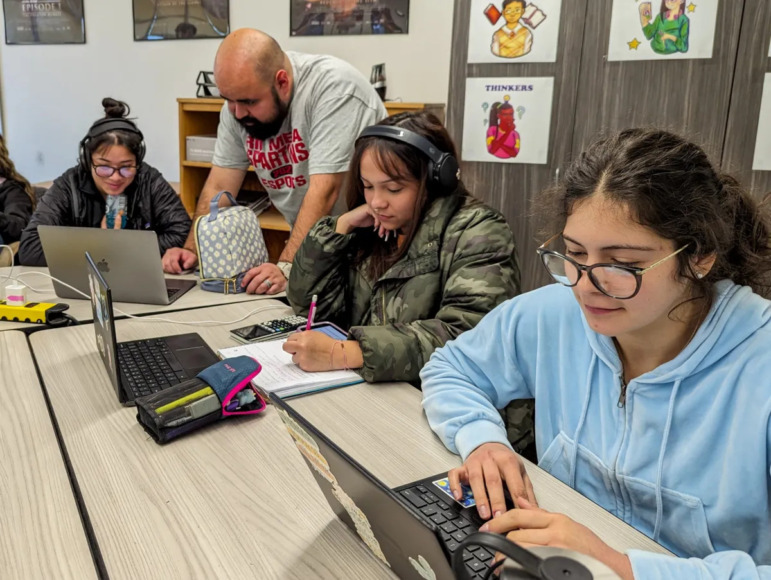
Javeria Salman/The Hechinger Report
Ruben Jacquez helps his students in a data science class at Rio Mesa High School as they work on their project on student stress levels.
In Oxnard, educators say they have been left in the dark about how these decisions affect course offerings for their students. They argue that, more than ever, students need real-world math to help them succeed in the subject, and that the expansion of data science — some 500 Oxnard district students have taken it to date — has reoriented teachers’ and students’ approach to math.
“Data science is changing their view of math,” said Jay Sorensen, Oxnard’s educational technology coordinator, who helped design the class. “It changed their perspective, or their view of what math is, because they maybe didn’t enjoy math or were frustrated with math or hated math before.”
[Related: Inside the new middle school math crisis]
Many kids in Oxnard stop taking any math after junior year of high school and the district has been trying to fix this for almost a decade. In 2015, Tom McCoy, then the assistant superintendent of education services, jokingly asked Sonny Sajor, the district’s math instructional specialist, “Can I get some math for poets?”
That started a conversation on what math classes might benefit and engage high schoolers who struggled in the subject and who didn’t plan to pursue science or math fields or attend a four-year college, said McCoy, who became Oxnard’s superintendent in 2020.
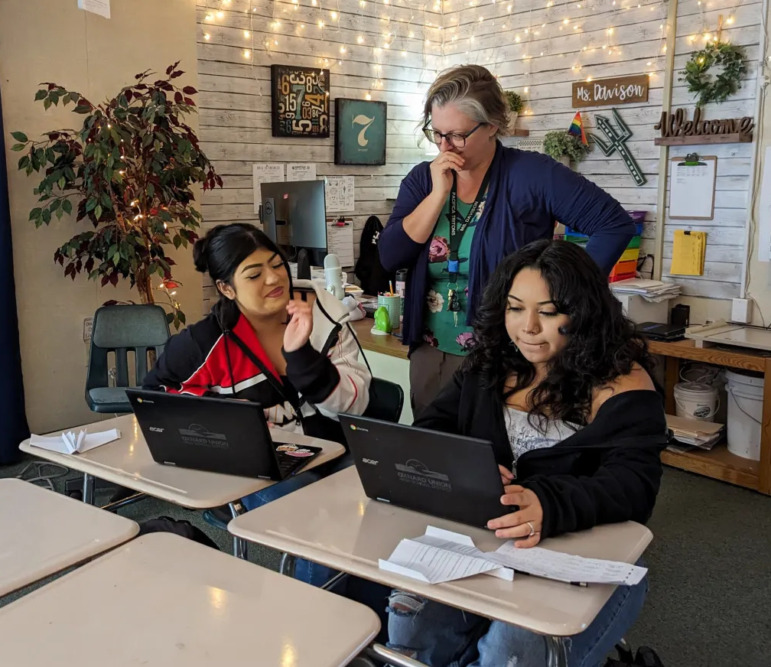
Javeria Salman/The Hechinger Report
Stefanie Davison, the district’s first teacher to teach data science, helps senior Emma-Dai Valenzuela (left) at Pacific High School.
“Too many kids that dislike math would stop taking math the minute they could,” said Sajor, who co-designed the course at Oxnard. In the year before the district launched Data Science, only about 45 percent of students who took Math I in ninth grade made it to Math III by their junior year.
Inspired by a University of California, Los Angeles, seminar they attended on data science for high schoolers, Sajor and Sorensen designed the new course and partnered on it with the ed tech vendor Bootstrap World. Oxnard’s first data science classes generated enough student interest that the district expanded the course to more schools, and its popularity has continued to grow. Perizzolo’s class, for example, was meant to have 30 students but enrolls 39; he says he won’t turn away a student who signs up for a math class.
But not all educators in Oxnard were on board. Some math teachers, for example, questioned whether the Data Science course — which had been approved as an advanced statistics course equivalent to general statistics courses — was really equivalent to an advanced math course.* They noted that the statistics content in the course was at a ninth-grade level, Sajor said.
Oxnard Union’s data science teachers, though, say they’ve seen benefits.
“It’s giving kids exposure to really practical math, and it’s also creative,” said Allison Ottie Halstead, who teaches Data Science along with Honors Pre-Calculus and A.P. Statistics at Rancho Campana High School.
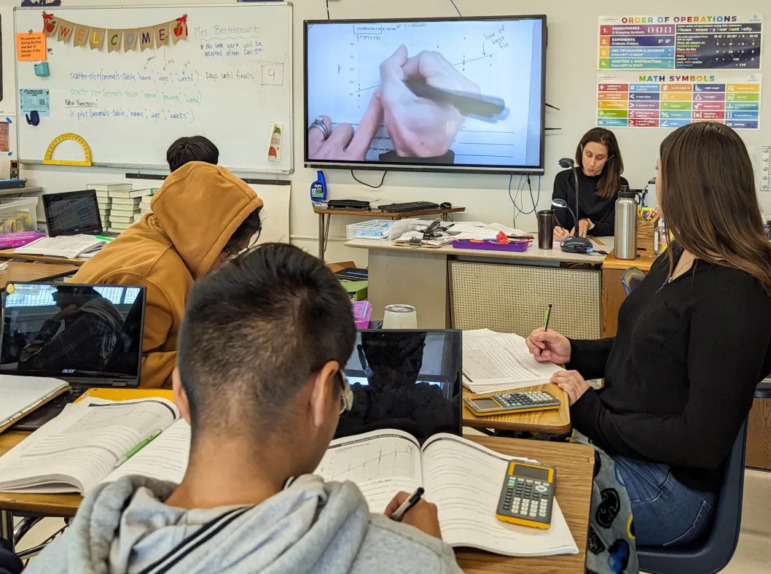
Javeria Salman/The Hechinger Report
Alicia Bettencourt, a data science teacher at Hueneme High School, walks her students through a Bootstrap World workbook lesson on functions. Bettencourt says teaching the course has made her rethink how she teaches her other math classes, including Algebra II.
Alicia Bettencourt, who teaches Data Science at Hueneme High School, said the course has helped her to “incorporate more real-world problems, more authentic assessments, when I’m teaching” other math classes including Algebra II.
Most of Oxnard’s Data Science classes enroll a mix of students who are using the course to fulfill their required third year of math and those who’ve already taken Algebra II. According to district data, students who took Data Science as juniors in the 2022-2023 year were more likely to sign up for a math class their senior year. (Only about 10 percent of those students enrolled in Math III, an integrated math class that’s equivalent to Algebra II; larger shares enrolled in Statistics, Math for Finance Literacy and other classes). Meanwhile, the share of students receiving a D or F in Math III has dropped slightly since the Data Science course was introduced in 2020, the district said.
Nizcialey Dimapilis, a senior in Hernandez’s class at Channel Islands High School, said she is taking Data Science and A.P. Calculus simultaneously to prepare for computer engineering courses in college. “I thought this class would be more useful because it involves coding, which is completely kind of new to me,” Dimapilis said. The course has helped her understand graphs and create and read data in her other classes as well, she said.
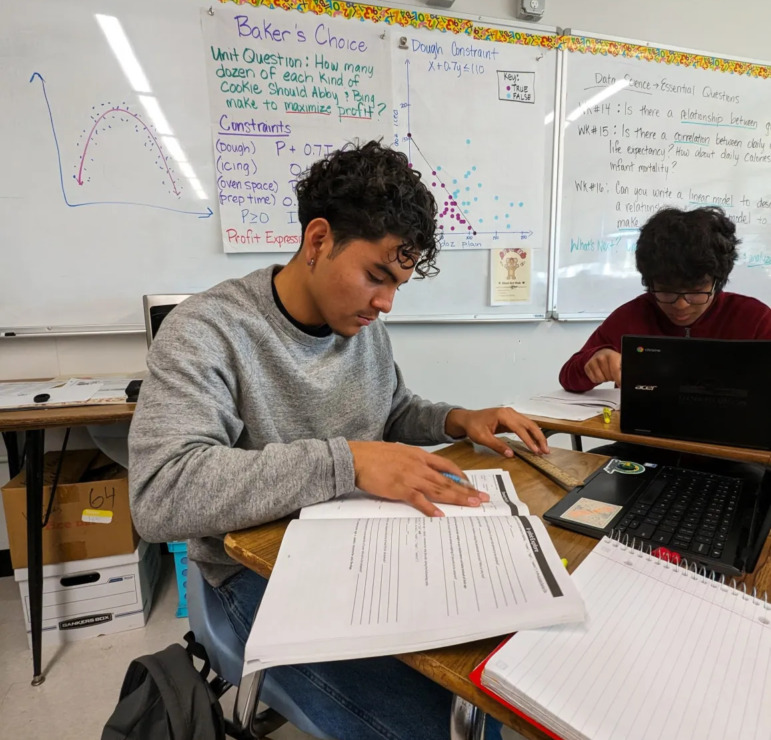
Javeria Salman/The Hechinger Report
Aaron Lira, a senior at Hueneme High School, said he finds data science interesting because he is learning skills that many companies use.
Some students said it helped them grasp math concepts they’d been introduced to in past classes and made them more interested in pursuing math in the future. Jaya Richardson, a senior taking Data Science at Oxnard High School, said she doesn’t consider herself “a math person.” As a junior, she took Math III and barely passed with a D.
Richardson considered repeating the class for a higher grade, but her counselor suggested Data Science instead. She said she’s happy with the decision, and even plans to pursue a degree in biology at a UC or CSU.
“This is way better,” she said of the Data Science course. “It’s still stressful, it’s still hard, but it’s more beneficial. We still do math in here, but it breaks it down in a way where I’m able to understand it without being overwhelmed.”
[Related: Teachers conquering their math anxiety]
But many STEM professors are worried about the consequences of experiments like Oxnard’s.
Jelani Nelson, professor of electrical engineering and computer sciences at the University of California, Berkeley, argues that most data science courses offered in high schools are low level and don’t comply with UC and CSU college admission criteria that alternatives to Algebra II build on students’ earlier math coursework.
Without an understanding of what he calls “foundational math” — Algebra I, Geometry, Algebra II — he says students won’t succeed in college courses in computer science, math, technology and economics. Even art can draw on foundational math, he noted (perspective drawing, for example, uses geometry).* Introductory college classes in data science also build on those math concepts, he said, so students who’ve taken data science in high school but not Algebra II are unlikely to succeed in the subject.
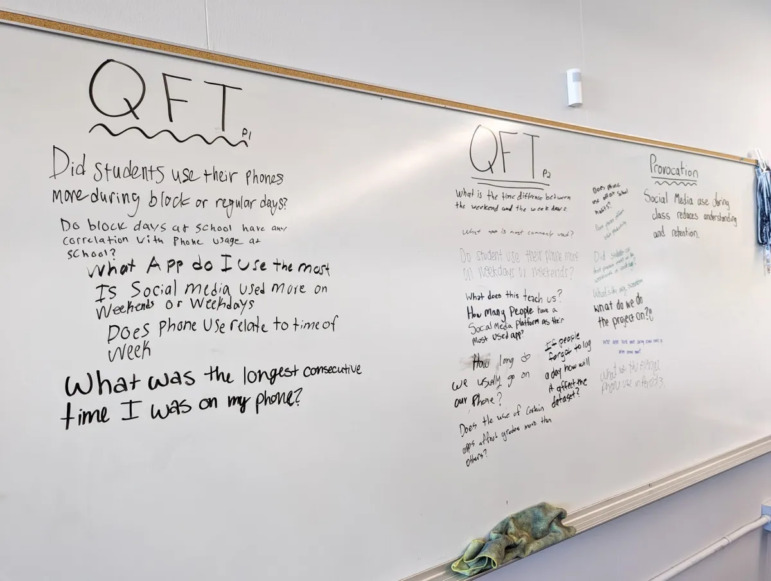
Javeria Salman/The Hechinger Report
Using what’s known as the “question formulation technique,” or QFT, students wrote inquiry-based questions at the start of their data analysis project in Dale Perizzolo’s data science class at Adolfo Camarillo High School.
Many four-year colleges don’t teach Algebra II, Nelson said, so there’s little opportunity to make up that work later. “If you want to get back on track,” he said, “how are you going to do it?”
Adrian Mims, founder of the Calculus Project, a nonprofit that works to increase the number of Black, Hispanic, Indigenous and low-income students in advanced mathematics, said swapping out data science for Algebra II has unintended consequences.
Standardized tests including the SAT and college math placement exams cover Algebra II, he said. He said he worries that students who opt for data science instead will be stuck in remedial math courses “not because they can’t learn the math, but because they made decisions in high school that deprive them of the opportunity to learn the content for them to do well.”
Rather than replacing Algebra II, data science concepts could be infused into Algebra II courses, and data science courses that include some Algebra II and geometry could be offered as electives to students who’ve already completed Algebra II, Nelson and others argue.
Others, though, don’t share those concerns. Pamela Burdman, founder of Just Equations, a nonprofit rethinking the role of traditional math pathways in high school, points to data showing that many students who take Algebra II in high school learn little.* She said emerging research suggests that courses like data science could have “more potential for bringing students into STEM” than the traditional preparatory math courses.
Despite the recent focus on the UC admissions requirements, only about 400 applicants out of roughly 206,000 in the last admissions cycle listed that they’d taken data science or statistics in lieu of Algebra II, she noted.
“I do worry that the debate over data science versus Algebra II is sort of a distraction,” she said.
Zarek Drozda, director of Data Science for Everyone, the national initiative based at the University of Chicago, agreed. “In the 21st century, if we can’t find opportunities to teach students about data, data science and AI basics, that is a huge problem,” he said.
[Related: How can schools dig out from a generation’s worth of lost math progress?]
Teachers and school guidance counselors in Oxnard are wary of wading into the math debate with their higher ed peers. But they aren’t afraid to voice their discontent with what they view as a disconnect between students’ needs and higher education.
“They’ve always moved the goal posts and I don’t know if they ever think about the students,” Hugo Tapia, a guidance counselor at Adolfo Camarillo High School, said about the state’s A-G university system.
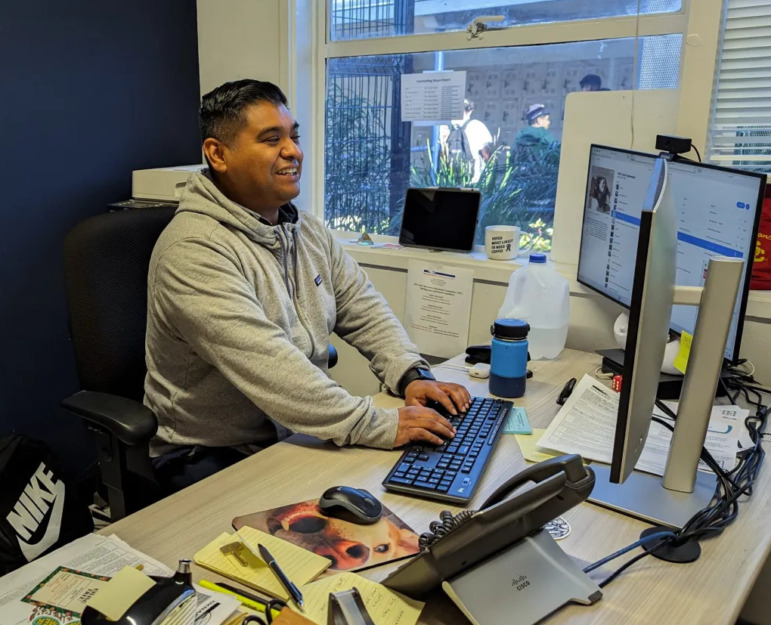
Javeria Salman/The Hechinger Report
Hugo Tapia is a guidance counselor at Adolfo Camarillo High School. “They’ve always moved the goal posts and I don’t know if they ever think about the students,” he said about the state’s four-year university system.
Daniel Cook, a learning, instruction and technology coach at Camarillo, said that students come into high school behind in math and that the pandemic only made the problem worse. Yet colleges still expect students to have mastered Algebra II concepts and shut the door on those who haven’t.
“If one A-G math is the only reason why a kid doesn’t get into college, we’re robbing those kids,” he said.
Cook said that at Camarillo High School, some 44 percent of sophomores are not on track to be A-G eligible because of math, so they’re getting a message early on that they’re not college material. By senior year, the figure is about 25 percent.
Traditional math curriculum “is essentially focused on preparing students for STEM pathways in college,” Cook said. The July vote and subsequent policy recommendations to nix data science as an option for college applicants, he said, are a “slap in the face to students who have interests that are not STEM related.”
[Related: How one district has diversified its advanced math classes — without the controversy]
Educators in Oxnard are trying to cope with the uncertainty created by the state’s higher education system. With data science no longer counting toward college admission, Oxnard will eventually limit the course to students who’ve already taken, or are taking, Algebra II, according to Sajor. The district is also considering a pilot course that would integrate Algebra II and Data Science.
Such a course might ultimately be better for the district, Sajor said, because it would help more students engage with Algebra II concepts while also introducing them to coding and data science. “It’s maybe a step back, but it also might be two steps forward,” he said.
Still, current data science students, like Emma-Dai Valenzuela, say the class in its current form has been invaluable. A senior in teacher Stefanie Davison’s class at Pacifica High School, Valenzuela said it has allowed her to fulfill her graduation requirements while actually succeeding in a math class.
She transferred into the class after struggling in Math III, the integrated Algebra II course, she said. Valenzuela plans to join the Navy before attending college, and said her recruiters told her this course would offer a basic understanding of coding and math she can build on later.
“This is more hands-on,” she said. “We’re constantly doing new things.”
***
Javeria Salman is a staff reporter for The Hechinger Report and writes their Future of Learning newsletter. She covers K-12 education issues through the lens of innovation and technology. Her work has appeared in Telemundo, The Atlanta-Journal Constitution, The Christian Science Monitor and the Solutions Journalism Network.
This story about data science was produced by The Hechinger Report, a nonprofit, independent news organization focused on inequality and innovation in education. Sign up for the Hechinger newsletter.
This story also appeared in The Washington Post.




























